Are you looking for the best-selling product able to be in constant demand? Then shoes are what you need to start your business. No matter what happens around, people always buy new clothes and footwear. So why not sell shoes online?
It would seem nothing could be easier: just develop a website, find suppliers, launch advertising, and you're golden! However, in truth, the situation is a lot more complicated.
The main problem is strong competition because you aren't the only one who wants to make money without extra costs and hassle. Hence, you have to try hard to get noticed among consumers. To set up an internet-based shoe store business, there is an extensive need for adaptive web development services that allow the e-business website to be responsive.
So, the question of the day is this one: how to start a shoe store without going bankrupt?
Let's discuss the issue at length.
Why sell shoes online?
Some business niches are always relevant, regardless of the time of the year, the situation in the country, and other negative phenomena that we cannot influence. And footwear, too, is on the list of in-demand e-commerce products. Yes, as we mentioned in the introduction, shoe shopping is going to be popular at all times.
Let's not be unfounded: judging by the research, the monthly expenses of an average family for this product category are from 8 to 20% of total income (and in some cases even more). Still further, the footwear market is growing by 5-10% annually (although it is far from reaching 100% of its potential).
Hence, starting a shoe store business is a profitable idea. And we're ready to substantiate our words. Moreover, later we'll also talk about the benefits of selling shoes online, using digital technologies (after all, it's high time to take advantage of our advanced era!).
Pros of shoe selling:
-
Hot selling product. As we said, people will always need new shoes as our boots wear out or go out of style. According to statistics, almost every adult purchases at least two pairs of footwear during the year. And some of us consider the process of buying shoes a way of relaxation (especially women).
-
Good income. Shoe stores make money, and good money, so you can count on a decent income (since the margin is about 80-150%).
-
Choice of assortment. You’re free to compose your assortment in such a way as to compete more successfully with other market players.
-
No need to purchase expensive equipment. Online shoe stores don’t need production facilities (you just have to find reliable suppliers).
However, before we describe how to start a shoe store, we feel it necessary to warn you what obstacles you may face.
Cons of shoe selling:
-
Financial investments. Any project requires money, and an online shoe store is no exception. So you have no choice but to accept the shoe store’s startup costs (they aren't enormous, but you cannot ignore them anyway).
-
Influence of fashion. If you focus on fashionable models of shoes, there is a risk that some of the products unsold during the season will become irrelevant over time (because trends are constantly changing).
-
High competition. You’ll have many competitors, and you should work hard to join the number of the most successful shoe stores.
But all the disadvantages described can be overcome (how exactly, you'll figure out after reading our article). Moreover, you may sell shoes online instead of offline and thereby significantly strengthen your market position.
Why is a digital approach to selling shoes so good? Because it allows you to…
-
manage your business remotely, anywhere in the world;
-
significantly save money, since it eliminates the need to rent premises for sale;
-
ensure the safety of customers who can enjoy shoe shopping remotely, without the necessity to contact other people (which is crucial under covid-19);
-
advertise your store more effectively (using SEO tools);
-
attract more customers;
-
keep up with the times and apply the most modern digital techniques.
How to start an online shoe store
Now let's figure out how to organize digital sales as efficiently as possible.
Step 1. Business registration
Initially, you should determine how you plan to work. Do you intend to cooperate with legal entities? If not, you just have to register as an individual entrepreneur.
Step 2. Find your niche
Now you need to figure out how you’re going to sell shoes online: in other words, choose your specific shoe market.
Type of shoes
In the first step of identifying your unique niche, you have to decide what type of footwear you plan to sell. You have two options:
-
distribution of any footwear (without a focus on a particular target group of buyers);
-
sale of a specific type of footwear.
However, keep in mind that selling a specific type of shoes is easier because there is no need to compete with the big market players. Otherwise, you'll have no choice but to invest a lot of money when starting your online shoe store.
Okay, let’s suppose, you've decided to do this the easy way. What options do you have? What type of shoes can you sell?
- Women's, men's, or children's shoes.
- Women's shoes. Let's say right away, the idea is good! And probably there is no point in explaining in detail why, right? After all, it is women who are dedicated shoe shopping fans. And they won't be satisfied with two or even three pairs of shoes. They want the trendiest models and often buy new boots just to please themselves.
- Men's footwear. Men are much less active when it comes to buying shoes. A few pairs of footwear are just enough for them, and they'll buy the next boots only when their old ones are completely worn out. So the main emphasis should be on the cheap and medium price segment, as well as on sports shoes, which wear out faster and are of increased interest among young guys.
- Children's shoes. Do you know how to start an online shoe store with the most active customers? Include children's footwear in the assortment! Kids are constantly growing, as you know, which means they need new shoes literally every few months. On the other hand, parents are very sensitive to their children, and therefore they'll have increased demands on the quality of baby shoes.
- Shoe type.
- Classic shoes. Let's start with classic footwear, including low shoes, sandals, boots, and more. The classic style is always in fashion, so the demand for such shoes remains high at all times.
- Sport shoes. Here's another great idea for starting your online shoe store! The fact is that people fond of sports buy shoes of this very type on a regular basis (as we've already said, sports footwear tend to wear out quickly). But even men and women who neither go jogging nor visit the gym love to wear sneakers and other sports shoes from time to time (and why not if they're really comfortable?). As a result, your online shoe store will always have active customers.
- Special (industrial/work) footwear. We're talking about footwear aimed at people of a certain profession, be it doctors, pharmacists, cooks, etc. These shoes must have special quality characteristics in order to properly perform their functions. For example, sometimes footwear should be protected from temperature extremes or aggressive external influences. It all depends on the field of activity.
- Handmade shoes. In this case, you can hardly hope for a constant influx of customers, but you have a chance to win the love of consumers who appreciate such handmade footwear.
- Indoor footwear. And finally, when thinking about selling a specific type of shoes, don't forget about indoor footwear: slippers, gym shoes, etc.
So, you've decided on the range of products. What else should you know to sell shoes online?
Of course, now you have to find out who he or she is, your average customer.
The target audience
Having identified a niche, you can easily determine your target audience either. Say, if you've opened a store of luxury shoes, your target customer is a wealthy, respectable person who wants to create a strong impression on others.
Now you need to specify the main characteristics of the potential consumer and his shoes buying habits:
-
the average age;
-
gender (that is, are there more men or women among your clients?);
-
average income;
-
lifestyle (active, passive);
-
the purpose of the purchase (everyday wear, special occasions, sports);
-
tastes in clothes. What style does your consumer prefer? Maybe he or she loves classics or, on the contrary, always chooses fashion trends? Besides, is the comfort in wear a must for him (her)?
-
shopping frequency.
We’ve figured out your customers’ shoes buying habits, but this isn't enough to move further according to the plan. Now let's divide the target audience of your online shoe store into several conditional categories:
-
Conservatives: people who prefer classic models and everything traditional;
-
Experimenters and fashion-mongers who aren't fond of wearing standard clothes and footwear. They love bright colors, quirky prints, fancy heels, and the like;
-
HLS fans: such consumers lead a healthy lifestyle and love comfortable ergonomic shoes;
-
People of high status, those who value their reputation. And shoes must be appropriate: stylish, expensive, branded.
-
Sybarites, namely, people who prioritize their own comfort. The shoes they wear should be as comfortable as possible;
-
Adherents of eco-fashion. These consumers are advocating green trends in all forms. They care about the environment and therefore choose what they call eco-shoes.
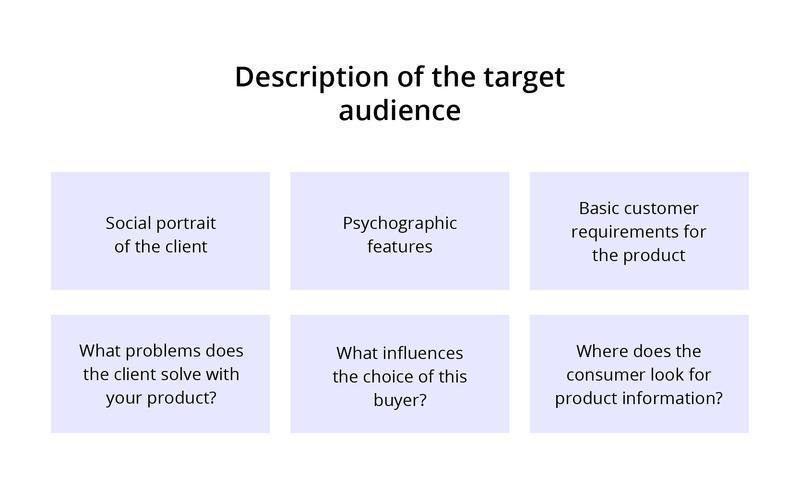
Okay, you know who you’re going to sell shoes online to. Now it's time to finally define your niche.
What is the right way to approach this issue?
How should you determine your specific shoe market?
To determine your niche and then plan your assortment, use the following simple techniques:
-
analysis of Google search queries in order to find out the products, the interest in which is now growing;
-
in-depth marketing analysis;
-
analysis of the lists of the most frequently sold products on large online marketplaces.
Now we can tell you how to start a shoe store for your chosen niche. And let's start with such an important stage as…
Step 3. Competitive analysis
Before creating your unique concept, you need to understand what other market players are offering. So you have to conduct a thorough analysis, identify the main sources of competitor traffic, and find out which triggers are especially effective given the audience you choose.
When analyzing competitors (the most successful shoe stores that use digital selling tools), pay attention to:
-
their assortment;
-
marketing and pricing policy;
-
reviews in social networks;
-
their main pros and cons;
-
the structure and usability of each online shoe store;
With all this data, you’re welcome to build your own strategy, focusing on:
-
the best ways to differentiate yourself from competitors;
-
a list of your competitive advantages;
-
developing effective ideas for promoting the resource.
Step 4. Choose a Business Model
Now we come to the most important and interesting part of our guide, which is defining the business model. After all, there is no point in starting your online shoe store if you haven't chosen the proper way of doing business yet.
Basically, there are three main online entrepreneurship schemes. We’d like to discuss each in more detail.
Dropshipping
Dropshipping is the most convenient cooperation model, especially with limited start-up capital. In this case, you act just as an intermediary between the manufacturer and the buyer and don't have to invest your own funds in the purchase of goods (that is, shoes).
Your task is to promote the online shoe store, collect orders, and send them to the manufacturer, who is responsible for packaging and delivering the goods.
Pros:
-
you can get by with the minimum start-up capital;
-
no need to think about production, storage, and shipping of goods;
-
your responsibilities come down to quality marketing and customer search.
Cons:
-
you’re completely dependent on a third party, i.e. the manufacturer. If the manufacturer doesn’t fulfill the customer's order or does it poorly, your reputation will suffer as well.

Wholesale commerce
Here we see an example of wholesale commerce. You buy a large consignment of goods, store them at your warehouse, and gradually sell them out.
But keep one point in mind: in order to sell shoes online using this business model, you need to have the required stock of inventory (which is footwear in your case) on an on-going basis.
Pros:
-
you are less dependent on the manufacturer;
-
you save on production;
-
order fulfillment depends only on you.
Cons:
-
you must have your own warehouse;
-
it requires constant investment in the purchase of goods.
Your own production
And the last business model is creating your own brand. More precisely, you (your company) manufacture and design the shoes. As you understand, this isn’t the easiest way to achieve your goal, what do you think?
Pros:
-
you’re your own boss and don’t depend on anyone;
-
you have the opportunity to take into account the wishes of customers and create the perfect shoes;
-
there is no need to look for suppliers and check the quality of their products.
Cons:
-
the method is rather complicated, time-consuming, and expensive. You have to create your own manufacturing company, so you won't do without a heavy shoe store’s startup costs.
Which of the above models should you prefer? We cannot give you advice without knowing your specific situation. So we recommend considering the following factors:
-
the chosen niche (your specific shoe market);
-
availability of a warehouse;
-
the amount of start-up capital;
-
geography of sales.
Step 5. Hire a team to sell shoes online
Of course, you don’t need to have a huge staff to sell shoes online but hire at least one person to help you. You can't handle the workload alone.
However, ideally, you have to cooperate with a lot more employees, such as:
-
consultant (aka client manager);
-
supplier relationship manager;
-
warehouse worker (if you aren’t working on a dropshipping model);
-
Internet marketer for running a web resource;
-
accountant.
Everything seems to be clear, right? It's time to get down to business... but the question is: how to start an online shoe store if you don't have the money to initiate your own production? Well, then you have no choice but to find worthy footwear suppliers.
Let's have a proper discussion on the issue, do you agree?
Step 6. Find wholesale shoe suppliers
There are several ways to find suppliers for starting a shoe store business:
-
search engines;
-
online directories of industry enterprises;
-
resources of well-known official shoe manufacturers;
-
thematic exhibitions, conferences, forums;
-
competitors' sites (that is, try to learn where other market players, owners of the most successful shoe stores, find suppliers).
What to consider when looking for suppliers?
-
Location. In order to save money, it is beneficial to buy goods wholesale from the nearest base. Thus, you significantly reduce transportation costs. On the other hand, sometimes it is more profitable to establish relationships with manufacturers abroad (which is smarter in the long run):
-
A number of online shoe stores prefer to arrange supplies of goods from China, which is a fairly budgetary and affordable option. However, you should bear in mind that not all Chinese-made shoes are of good quality. If you want to reduce spoilage to a minimum, order only certified footwear in the middle and high price range.
-
If you've opened a store of luxury shoes, then you need to find a manufacturer of branded footwear. It is believed that manufacturers of this level are the easiest to find in Italy.
-
High-quality budget goods are usually purchased in Turkey or Morocco. Of course, transportation costs will be quite high.
-
-
The quality of the shoes. When starting your online shoe store, pay special attention to the quality of your products. Customer feedback matters a lot, especially at first. Therefore, the shoes you buy wholesale must be upscale.
-
Supply stability. Make sure the manufacturer won’t delay the delivery of goods. Otherwise, sooner or later you may find yourself in a situation where you cannot fulfill the client's order on time.
-
The possibility of deferred payment, which is also an important condition if one wants to build a mutually beneficial partnership.
Step 7. Decide where to sell
You’ve found suppliers, have compiled a range of products, and it's finally time to sell shoes online. However, where is the best place to start selling?
#1. Social networks
Undoubtedly, using social media to sell online is the easiest option, and it usually comes to mind first. And why not? You just need to create a page on Instagram or Facebook, and your online shoe store is ready to go. As a bonus, you get the opportunity to easily promote your account and attract a lot of new customers.
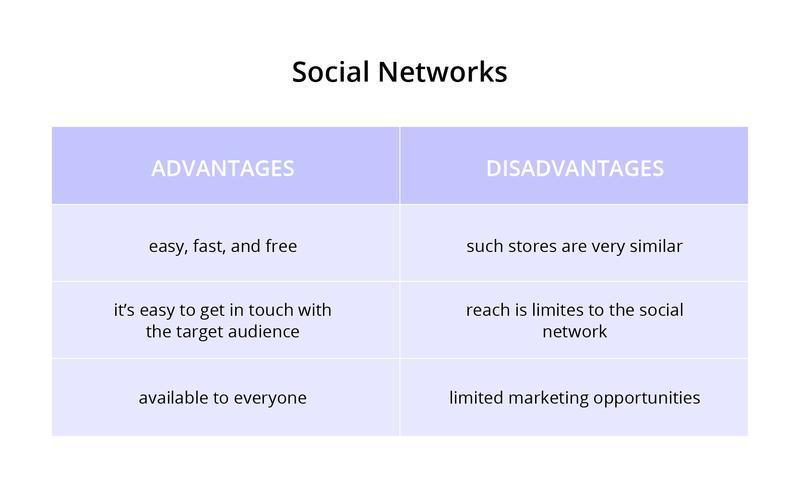
#2. Major marketplaces
Social networks are good, but they are somewhat amateurish. A much more professional way of doing things is to resort to the services of large marketplaces like Amazon, which act as intermediaries between the seller and the buyer. People often use these platforms when buying shoes and other goods. So you won't have a shortage of customers, the task is to convince them that your store is the best.
Then again, you'll probably have to pay a fee to the owners of the marketplace, so your expenses, including the shoe store’s startup costs, will increase. But there's nothing you can do about it.
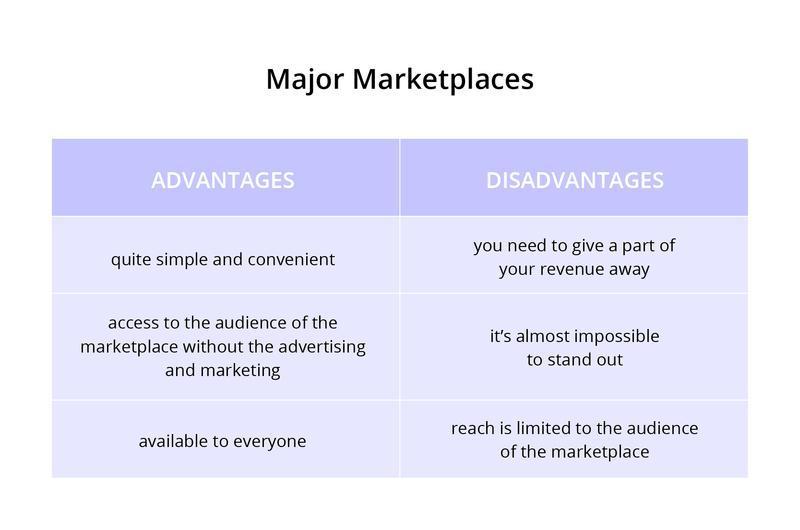
#3. Website from scratch
Of course, the ideal way to sell shoes online is to create an e-commerce platform. You can act on your own and have complete control over the situation. Plus, you don't have to pay any commission, so all the money goes to you.
Of course, building a website from scratch isn’t an easy task. You should pay attention to the following points:
-
Hosting choice. Choose a reliable hosting provider that guarantees quality maintenance.
-
Intuitive UI/UX. The interface of your resource should be intuitive and user friendly. Trust us, website usability plays an important role. Therefore, properly structure the assortment of shoes and place the basket in a prominent place on the web pages.
-
Responsive version. Your site should display correctly on small screens of different types of smartphones. After all, many people prefer to use their mobile devices for shoe shopping.
-
Omnichannel approach. Provide the client with the opportunity to contact you not only through the form on the website but also using other channels, including instant messengers and social networks.
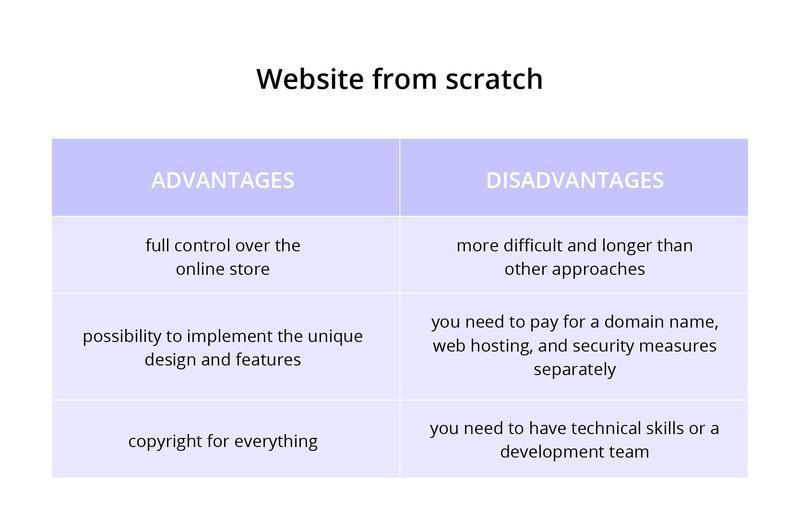
The most successful shoe stores have their own websites (though many of them use the services of marketplaces at the same time, one thing doesn’t prevent the other.). Of course, creating a web resource is an expensive and complicated task. Fortunately, there is a way to make it simpler and cheaper.
#4. Website development using ready-made solutions
This is an easier way to approach the above issue. Instead of creating a website from scratch, you just use ready-made cloud solutions like BigCommerce and Shopify and launch the resource without unnecessary hassle (and quickly enough). Surely, your platform won't have unique features and design, but sometimes the game is worth the candle, especially with a limit of time or money.
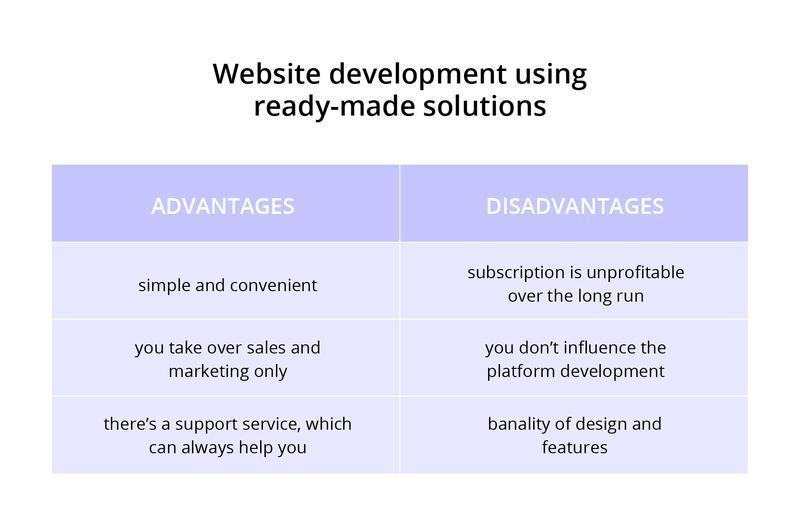
We told you how to start a shoe store and make it digital. But we're not done, we still have something to discuss.
Step 8. Delivery and Payment systems
Don't forget to think about efficient delivery and payment systems. The main trick is to provide the consumer with as many choices as possible.
Payment
We’re all different, which is natural, so each of us has his own taste. This also applies to payment preferences. So we recommend adding several payment methods when starting your online shoe store. Otherwise, you risk losing some of your customers.
What payment methods are required in the first place?
-
cash payment;
-
payment on delivery;
-
cashless payment (by bank cards, through terminals, e-wallets, and other services);
-
bank transfer.
Delivery of goods
When it comes to shipping, customers want a choice too. So be sure to offer them multiple options.
It would be ideal to organize several pick-up points, establish cooperation with one or more courier services, and also provide the opportunity to deliver goods to the client's home.
-
By the way, don’t fail to add a real-time order tracking feature. This will allow the buyer to know where his package with footwear is at any given time.
And now let's talk about how to help your resource rank among the top market players, the most successful shoe stores.
Step 9. Write an efficient marketing strategy
Let's say you've created your website and are ready to sell shoes online. But how do you attract your first customers? How to get recognition among shoe shopping fans?
There is only one way out: you have to do your best and develop an effective marketing strategy. Its main steps include the following:
-
SEO optimization designed to raise your website in search results. You can hardly optimize your resource on your own, so it's better to seek help from an SEO specialist.
-
Contextual advertising, which is a great way to promote your platform among potential consumers. Use these ads to let users know about your online shoe store.
-
Email marketing, which is also a wonderful promotion tool to help you stay in touch with your customers and deliver good news to them, whether it's an annual sale or new product arrivals. You can also remind users of abandoned shopping carts or ask customers if they liked the items they've already bought.
-
Social networks. The best way to make friends with your consumers is to invite them to like your page on social media and communicate with them through your posts. React to user comments, answer their questions, conduct polls. And of course, don't forget about targeted advertising!
-
Company blog. Having a blog with articles will help promote your site too. This way, you can answer some of the users' questions even before they ask them.
-
Improving the company's reputation. Make your brand recognizable. Let's give a couple of useful tips:
-
develop a corporate identity;
-
publish customer reviews;
-
create viral social media posts.
-
Step 10. Calculation of the shoe store’s startup costs
If you decide to make and design the shoes on your own, you'll have to fork out a lot. On the other hand, if you choose a wholesale or dropshipping model, your costs won't be that high... but you'll need to prepare the budget anyway.
Let's figure out what you have to allocate money for:
-
development of a competitive e-commerce platform (hire professional developers);
-
salaries of your employees (since we advised you to hire at least one assistant);
-
creation of stocked goods (when working on a wholesale trade scheme);
-
office and, if necessary, warehouse rent;
-
advertising activities;
-
taxes.
How to make your site one of the most successful shoe stores
We've explained to you how to start an online shoe store, but how to make it truly successful? Are there any additional tips to help you compete more effectively with the top resources of the market?
Of course, there are such tips:
-
Inviting name. First of all, your store must be named, and named correctly! The perfect name should be catching, easy to read, pronounce, and remember. Also, it must be associated with the company's activities and has a beautiful sounding.
-
Renewal of the assortment on a regular basis. Be sure to analyze your sales and act accordingly. Say, if a particular type of footwear shows very low sales rates, make the right conclusions and exclude this model from the product range (stock balances can be sold at cost). Conversely, buy high-demanded footwear in large quantities.
-
The possibility to return goods. When shopping online, consumers can't try new shoes on right away. They'll inspect them later when they receive the package and bring it home (or at one of your pick-up points). So you must provide an opportunity to return the footwear if the buyer reasoned it didn't meet his expectations (of course, provided he hasn't damaged it when trying it on).
-
24/7 support. Your online shoe store should run like clockwork. Process orders and respond to customers' questions and comments as quickly as possible. Users are very demanding today, and if you don't answer them within a few minutes, they're likely to go to your competitors.
-
Competent competitive strategy. You have a lot of competitors since the whole niche is really profitable (online shoe stores do make money). So you should think carefully about how you're going to poach customers. Here are some simple tricks that experienced businessmen use:
-
discounts on the purchase of a second pair of shoes;
-
accumulative points systems;
-
free delivery around the city;
-
additional bonuses, gifts.
-
-
Convincing product descriptions. Particular attention should be paid to the following things when filling out the product card:
-
correct size table;
-
images of shoes from different angles;
-
description of the footwear parameters;
-
price indication.
-
-
Unique features. It would be good if your store has some unique feature that sets you apart from the competition.
Now you know everything you need to start your own business. It's time to put your knowledge into practice.


